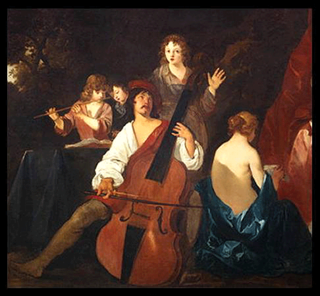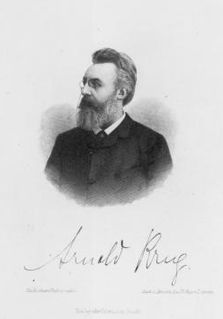Related Research Articles

The cello ( CHEL-oh; plural celli or cellos) or violoncello ( VY-ə-lən-CHEL-oh; Italian pronunciation: [vjolonˈtʃɛllo]) is a bowed (and occasionally plucked) string instrument of the violin family. Its four strings are usually tuned in perfect fifths: from low to high, C2, G2, D3 and A3, an octave lower than the viola. Music for the cello is generally written in the bass clef, with tenor clef and treble clef used for higher-range passages.

The viola ( vee-OH-lə, alsovy-OH-lə, Italian: [ˈvjɔːla, viˈɔːla]) is a string instrument that is bowed or played with varying techniques. It is slightly larger than a violin and has a lower and deeper sound. Since the 18th century, it has been the middle or alto voice of the violin family, between the violin (which is tuned a perfect fifth above) and the cello (which is tuned an octave below). The strings from low to high are typically tuned to C3, G3, D4, and A4.

A concerto is a musical composition generally composed of three movements, in which either one solo instrument or a group of soloists (concertino) is accompanied by an orchestra or concert band. Its characteristics and definition have changed over time. In the 17th century, sacred works for voices and orchestra were typically called concertos, as reflected by J. S. Bach's usage of the title "concerto" for many of the works that we know as cantatas.

The viola d'amore is a 7- or 6-stringed musical instrument with sympathetic strings used chiefly in the baroque period. It is played under the chin in the same manner as the violin.

A string quintet is a musical composition for five string players. As an extension to the string quartet, a string quintet includes a fifth string instrument, usually a second viola or a second cello, or occasionally a double bass.

A string orchestra is an orchestra consisting solely of a string section made up of the bowed strings used in Western Classical music. The instruments of such an orchestra are most often the following: the violin, which is divided into first and second violin players, the viola, the cello, and usually, but not always, the double bass.
Scordatura[skordaˈtuːra], is a tuning of a stringed instrument different from the normal, standard tuning. It typically attempts to allow special effects or unusual chords or timbre, or to make certain passages easier to play. It is common to notate the finger position as if played in regular tuning, while the actual pitch resulting is altered. When all the strings are tuned by the same interval up or down, as in the case of the viola in Mozart's Sinfonia Concertante for Violin, Viola and Orchestra, the part is transposed as a whole.
A violotta is a tenor viola (or tenor violin) invented by the German luthier Alfred Stelzner and patented in 1891. It is tuned G2–D3–A3–E4, an octave below the violin. Other instruments called "tenor violin" were tuned a step lower: F2–C3–G3–D4 (a fifth below the viola).

In classical music, a string sextet is a composition written for six string instruments, or a group of six musicians who perform such a composition. Most string sextets have been written for an ensemble consisting of two violins, two violas, and two cellos.

Felix August Bernhard Draeseke was a composer of the "New German School" admiring Franz Liszt and Richard Wagner. He wrote compositions in most forms including eight operas and stage works, four symphonies, and much vocal and chamber music.
Alfred Stelzner was a German composer and luthier.

The term violone can refer to several distinct large, bowed musical instruments which belong to either the viol or violin family. The violone is sometimes a fretted instrument, and may have six, five, four, or even only three strings. The violone is also not always a contrabass instrument. In modern parlance, one usually tries to clarify the 'type' of violone by adding a qualifier based on the tuning or on geography, or by using other terms that have a more precise connotation. The term violone may be used correctly to describe many different instruments, yet distinguishing among these types can be difficult, especially for those not familiar with the historical instruments of the viol and violin families and their respective variations in tuning.

The violin family of musical instruments was developed in Italy in the 16th century. At the time the name of this family of instruments was viole da braccio which was used to distinguish them from the viol family. The standard modern violin family consists of the violin, viola, cello, and double bass.

Arnold Krug, was a German composer and music teacher. Gustav Jenner was among his many students.

The string section is composed of bowed instruments belonging to the violin family. It normally consists of first and second violins, violas, cellos, and double basses. It is the most numerous group in the typical Classical orchestra. In discussions of the instrumentation of a musical work, the phrase "the strings" or "and strings" is used to indicate a string section as just defined. An orchestra consisting solely of a string section is called a string orchestra. Smaller string sections are sometimes used in jazz, pop and rock music and in the pit orchestras of musical theatre.

A tenor violin (or tenor viola) is an instrument with a range between those of the cello and the viola. An earlier development of the evolution of the violin family of instruments, the instrument is not standard in the modern symphony orchestra. Its tuning, typically G2–D3–A3–E4 – an octave below the traditional violin, places the range between the cello and viola and thus is sometimes confused with the modern baritone violin which has the same tuning on the standard violin body. As a formal development, the 17th-century tenor violin existed as an instrument with a body larger than a viola but with a short neck. In earlier designs, the tenor was played upright in the musician's lap. Tenor violin parts were written in tenor clef.

The Chamber Symphony No. 1 in E major, Op. 9 is a composition by Austrian composer Arnold Schoenberg.
A Garland for Dr. K. is a set of eleven short compositions created in 1969 for the celebration of the eightieth birthday of Dr Alfred Kalmus, the director of the London branch of Universal Edition. It is also the title of an album containing these eleven pieces of music, recorded in 1976.
Kaspar Johann Kummer (1795–1870) was a German flautist, professor and composer.
Dr James Weeks is a British composer, conductor and teacher of composition.
References
- ↑ "Dr. Alfred Stelzner: Pioneer in Violin Acoustics". Draeseke.org. Retrieved 2014-01-18.
- ↑ "Bassetto historisch - Cellone und Sous-Basse". Silvio Dalla Torre. Retrieved 2014-01-18.
- ↑ "AK Coburg Recordings - Music of Draeseke - release DR 0010". Draeseke.org. Retrieved 2014-01-18.
